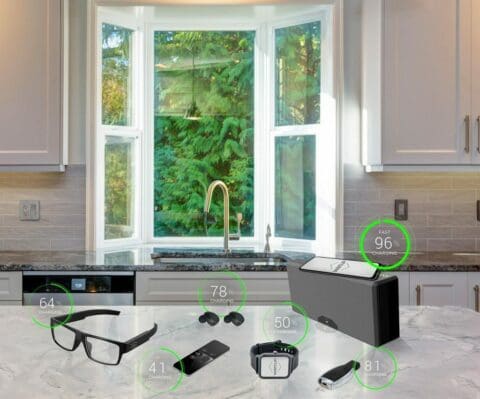We have it pretty good when it comes to technology, don’t we? Generally speaking, we no longer worry about processing complexity thanks to Moore’s Law, we rarely have to worry about connectivity thanks to Wi-Fi and Cellular networks, and backups for all of our data have really become a second thought thanks to advancements like solid-state and cloud-based storage.
 One thing we do still worry about is the battery status for all of our devices: think about how many times we have to stop what we are doing and find a way to recharge or power the devices that have become so essential to our everyday lives.
One thing we do still worry about is the battery status for all of our devices: think about how many times we have to stop what we are doing and find a way to recharge or power the devices that have become so essential to our everyday lives.
The ability to charge a variety of devices wirelessly is seen as the next frontier that would enable a true untethered ecosystem for all kind of devices. This need is becoming even greater as devices become smarter and more connected, serving a growing number of consumers, enterprise, retail, defense and industrial applications. We expect this trend to continue and accelerate. The increased bandwidth associated with 5G, coupled with the continued expansion of mobile devices and the maturity of both commercial and industrial IoT applications will exacerbate the power problem and drive the need for wireless power solutions. Initially, it is going to be a 1:1 Tx/Rx pairing, likely expanding to a closed ecosystem from a Tier-1 consumer electronics company, and finally leading to an open ecosystem driven by an RF wireless charging standard combined with in-box charging solutions.
Wireless power is not a new concept. Nikola Tesla demonstrated it 100 years ago so why has it taken that long for this technology to reach the mainstream?

Primarily, the challenges have been in reaching commercial viability and passing the necessary regulatory approvals. The challenge of commercializing wireless power is what brought all of us together at Energous Corporation– an RF wireless power pioneer based in San Jose, CA. Through collaborations with market leaders in multiple segments, Energous has built a portfolio of technologies that are shaping the future of RF power. At the core, the roadmap for wireless power has been shaped by global regulatory requirements and a fluid definition of commercial viability which has brought together an entire industry working to find the best way to support the ultimate goal of RF power – untethered with orientation freedom while the devices are in use.
Unfortunately, there is no shortcut. Any company interested in participating is going to have to go through the valley of fire to develop the integral components of new technology – silicon ICs, specialized antennas, software and system integration that can deliver not only commercial viability but also enable worldwide regulatory approvals. We at Energous understand this more than anyone. Having said that, we broke through the logjam and are working with leading customers to launch Wireless Charging 2.0 on a global basis.
Commercial viability is measured in terms of solution size, incremental cost, Tx/Rx implementation complexity and meeting consumer expectations. Although these expectations and requirements vary across consumer, industrial and defense applications, these are the main hurdles that wireless power continues to negotiate for the broad adoption. A key to commercial viability is the silicon portfolio, as it drives the size, cost and thermal performance. Energous has developed a significant and diverse portfolio of Tx-IC, Power Amplifier (1W to 100W) and Rx-ICs (10mW to 40W) with CMOS, GaN and GaAs technologies. When this chip portfolio is combined with system, antenna and software capabilities, we start to see the true commercial viability with a viable size and cost while delivering significant Rx Power while meeting all regulatory requirements.
Safety is driven by how the technology navigates the emission, co-existence and absorption limits as prescribed by global regulators. Thanks to the variety of RF technologies participating in the market today, there is a very good understanding of what needs to be done to meet these requirements on a global basis. However, the real challenge is how to satisfy the regulatory requirements and still meet the performance expectations, specifically as they relate to Tx Power, Rx Power, Tx-Rx distance and Antenna Size/cost for a given frequency of operation.
Keeping all this in mind, our position at Energous has always been that the RF roadmap is going to be incremental, balancing the ever-increasing commercial viability and regulatory limits as the technology progresses and adoption increases.
Understanding the following areas is important to design a best-in-class RF wireless power solution.
- Tx and Rx distance
- Use case flexibility
- The frequency for power transfer
- Balancing the system link budget all the way from Tx to Rx
- Antenna design including beamforming techniques for the given Tx and Rx size
When we factor in many of the design criteria, the incremental approach provides the most logical path to unlock the significant market opportunity for RF power as defined by an 8-Zone model. As shown here the solution space is segmented in the 8-Zone framework based on Rx Power and Tx-Rx distance. A scalable Tx/Rx architecture with a portfolio of TxIC, PA and RxIC matched to the solution. This approach has been validated and confirmed with the help of our design partners who continue to work towards bringing more and more solutions to market in alignment with the Energous Roadmap.
Disrupting the status quo in an industry that is creating any new technology is never an easy feat. With RF, it is exponentially challenging considering the steps needed to bring it to market but we do see light at the end of the tunnel. Thanks to ALL our partners who are collaborating with us to launch this exciting new technology.
In summary, RF power adoption is a paradigm shift from thinking about how fast you can charge a device to eliminating the worry in charging – just as we saw take place with processing, storage and connectivity.
Our goal with this article, coupled with a series of planned Webinars, will be to share the learnings we have gained as we continue to progress towards the ultimate goal of building a truly wireless future.
You are invited to join us for our first webinar on April 28th at 10 am PT to learn more about some of the recent advancements we’ve made and how you can take advantage of RF wireless power for your products. We will post more details about this webinar in the coming days.

